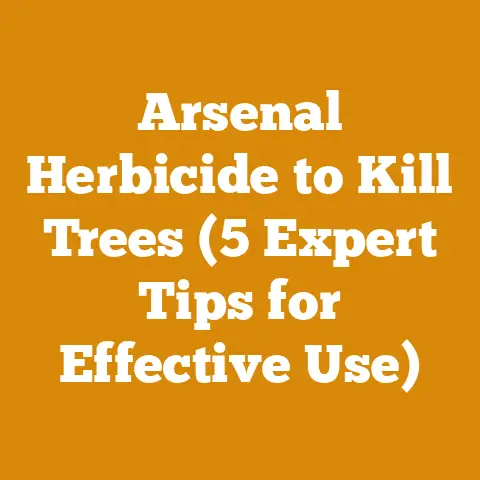Burning a Stump Out: Effective Wood Removal Tips (Pro Arborist Guide)
But what about the silent giant left behind—the stump? A stubborn reminder of the tree that once was, a stump can be an eyesore, a tripping hazard, and a downright nuisance. Many methods exist for getting rid of them, but today, I’m going to share my insights on a method that’s been around for ages: burning it out. This isn’t your everyday backyard bonfire; it’s a controlled, strategic process, and I’m here to guide you through it, pro arborist style.
Burning a Stump Out: Effective Wood Removal Tips (Pro Arborist Guide)
Let’s get one thing straight: burning a stump out isn’t always the best or most practical option. Environmental regulations, local ordinances, and the proximity of structures all play a role. But when the conditions are right, and you’ve taken the necessary precautions, it can be a surprisingly effective and relatively low-impact way to reclaim your space.
Understanding the Intricacies of Stump Removal
Before we even think about lighting a match, let’s delve into the heart of the matter: why are we doing this, and what are the alternatives?
- Why Burn? Burning is often chosen for its simplicity and cost-effectiveness, especially for larger stumps that would be expensive to grind or dig out. It can be a viable option in rural areas where open burning is permitted and where heavy machinery access is limited.
- The Alternatives: Stump grinding uses a specialized machine to chip away at the stump. It’s faster than burning but requires equipment rental and can be messy. Digging is labor-intensive and usually only feasible for smaller stumps. Chemical stump removers accelerate decay but take months to work.
- The Environmental Considerations: Burning releases carbon dioxide into the atmosphere, contributing to greenhouse gases. It also poses a fire risk if not carefully managed. Grinding, while less polluting in terms of emissions, can disturb the soil and impact surrounding vegetation.
Assessing the Situation: Is Burning Right for You?
This is the crucial first step. Don’t even think about grabbing the kerosene until you’ve answered these questions:
- Local Regulations: Check with your local municipality or fire department about open burning regulations. Many areas have restrictions on burning, especially during dry seasons. Permits may be required, and fines can be hefty for non-compliance.
- Proximity to Structures: How close is the stump to your house, garage, fence, or neighboring properties? Burning stumps can produce intense heat and embers that can travel long distances. A general rule of thumb is to maintain a clear radius of at least 50 feet, but this can vary depending on wind conditions and the size of the stump.
- Soil Conditions: Is the soil around the stump dry and easily combustible? Dry peat moss or other organic matter can ignite and spread the fire. Ensure the surrounding area is clear of dry vegetation and debris.
- Tree Species: Some wood species burn more readily than others. Softwoods like pine and fir tend to ignite easily, while hardwoods like oak and maple can be more stubborn. The resin content of the wood also plays a role. For example, pine stumps are full of resin, making them burn hotter and longer.
- Stump Size and Condition: Larger stumps will require more fuel and time to burn completely. Decayed stumps may burn more easily but can also be unstable and collapse during the burning process.
Preparing for the Burn: Safety First!
This is where we put on our thinking caps and plan for every contingency. Safety is paramount.
- Clear the Area: Create a firebreak around the stump by clearing a 10-foot radius of all vegetation, debris, and flammable materials. Rake the area down to bare soil.
- Water Source: Have a readily available water source nearby, such as a garden hose connected to a reliable water supply or several buckets of water.
- Fire Extinguisher: Keep a Class A fire extinguisher on hand, specifically designed for extinguishing wood fires.
- Tools: Gather essential tools, including a shovel, rake, axe, and metal probe. The shovel is for containing the fire, the rake for spreading embers, the axe for breaking up large pieces of wood, and the probe for checking for remaining hot spots.
- Personal Protective Equipment (PPE): Wear appropriate PPE, including safety glasses, gloves, long sleeves, and sturdy boots. A dust mask or respirator is also recommended to protect against smoke inhalation.
- Notify Neighbors: Inform your neighbors of your plans to burn the stump, especially if they are downwind. This is just common courtesy and can prevent unnecessary alarm.
- Weather Conditions: Check the weather forecast before starting the burn. Avoid burning on windy days or during periods of high fire danger.
The Burning Process: A Step-by-Step Guide
Now for the main event. Remember, patience is key. This isn’t a race; it’s a controlled burn.
- Drilling and Fueling: Drill several holes into the top of the stump, using a drill bit at least 1 inch in diameter. The more holes, the better the airflow and the faster the burn. Pour kerosene, diesel fuel, or charcoal lighter fluid into the holes. Let the fuel soak into the wood for at least 30 minutes. Note: I personally prefer kerosene, as it burns cleaner than diesel and is less volatile than gasoline.
- Ignition: Carefully ignite the fuel in the holes, using a long-handled lighter or a propane torch. Stand back as the flames spread.
- Maintaining the Fire: As the fire burns, add more fuel as needed to keep it going. You can also add dry wood or charcoal to the fire to increase the heat. Use the axe to break up large pieces of wood and to create more airflow.
- Monitoring and Containing: Constantly monitor the fire and ensure it doesn’t spread beyond the cleared area. Use the shovel to contain any embers that escape. Keep the water source and fire extinguisher readily available in case of emergencies.
- Patience is a Virtue: Burning a stump can take several hours, or even days, depending on the size and condition of the stump. Be patient and don’t leave the fire unattended.
The Aftermath: Extinguishing and Cleanup
Once the stump has burned down to ground level, it’s time to extinguish the fire and clean up the area.
- Extinguishing the Embers: Use the water source to thoroughly soak the remaining embers and ashes. Stir the ashes with the shovel to ensure all hot spots are extinguished.
- Checking for Hot Spots: Use the metal probe to check for any remaining hot spots underground. Push the probe into the soil around the stump and feel for heat. If you find any hot spots, soak them with water.
- Cleanup: Remove the ashes and debris from the area. You can use the ashes as fertilizer in your garden, but be sure to test the pH level first, as wood ash is alkaline.
- Filling the Hole: Fill the hole with soil, sand, or gravel. Tamp the soil down firmly to prevent settling.
- Replanting: If you plan to replant the area, choose a tree or plant species that is compatible with the soil conditions.
Data-Backed Insights: Wood Species and Burning Efficiency
Not all wood burns the same. Understanding the properties of different wood species can significantly improve your burning efficiency and safety. Here’s a quick rundown:
- Softwoods (Pine, Fir, Spruce): High resin content, easy to ignite, burn quickly and hot. Ideal for starting fires but require more frequent refueling.
- Data Point: Pine has a BTU (British Thermal Unit) rating of approximately 20 million per cord, while fir ranges around 22 million. This means they release a significant amount of heat per unit volume.
- Hardwoods (Oak, Maple, Ash): Denser wood, more difficult to ignite, burn slowly and steadily. Produce long-lasting coals and less smoke.
- Data Point: Oak, a popular firewood choice, boasts a BTU rating of around 28 million per cord. This higher density translates to more energy stored within the wood.
- Resin Content: High resin content increases flammability but also produces more smoke and creosote buildup in chimneys.
- Unique Insight: Pine stumps, often saturated with resin, can be challenging to extinguish completely. Monitor them closely and be prepared to use ample water.
- Moisture Content: Dry wood burns much more efficiently than wet wood. Seasoned wood (dried for at least six months) has a moisture content of 20% or less, while green wood can have a moisture content of 50% or more.
- Data Point: Burning green wood can reduce heating efficiency by as much as 50% and increase smoke production significantly.
Tool Selection: Beyond the Basics
While a shovel and axe are essential, a few specialized tools can make the burning process safer and more efficient.
- Pulaski Axe: A combination axe and adze, ideal for clearing vegetation and digging firebreaks.
- Fire Rake: A specialized rake with heat-resistant tines, designed for spreading embers and clearing debris.
- Infrared Thermometer: Allows you to remotely measure the surface temperature of the stump and surrounding area, helping you identify hot spots.
- Chain Saw: I know this is about burning stumps, but a chainsaw is an essential tool for cutting away any accessible portions of the stump before burning, which can help speed up the process.
Case Study: The Stubborn Oak
I once had to remove a massive oak stump from a client’s property. It was in a relatively remote area, and grinding wasn’t an option due to the terrain. Digging was out of the question given the stump’s size (over 4 feet in diameter). Burning seemed like the only viable solution.
- Equipment Used: Chainsaw, drill, kerosene, Pulaski axe, fire rake, water pump with a long hose.
- Wood Type: Oak (extremely dense and slow-burning).
- Safety Considerations: The stump was located near a wooded area, so we took extra precautions to clear a wide firebreak and monitor the wind conditions.
- The Process: We started by using the chainsaw to cut away as much of the stump as possible above ground. Then, we drilled numerous holes into the remaining stump and saturated it with kerosene. It took several days of burning and constant monitoring to completely reduce the stump to ashes.
- Lessons Learned: Oak stumps require significantly more fuel and time to burn than softwood stumps. Patience and vigilance are essential.
Overcoming Challenges: Troubleshooting Tips
Burning a stump isn’t always smooth sailing. Here are some common challenges and how to overcome them:
- Stump Won’t Ignite: Ensure the wood is dry and that you’ve used enough fuel. Try using a propane torch to ignite the fuel. You can also create a small teepee of dry kindling over the holes to help the fire get started.
- Fire Is Spreading: Immediately extinguish the fire with water or a fire extinguisher. Clear a wider firebreak around the stump and monitor the wind conditions more closely.
- Stump Is Decaying: Decayed stumps can be unstable and collapse during the burning process. Use caution when working around them and be prepared for unexpected shifts in the fire.
- Smoke Is Excessive: Ensure the wood is dry and that you’re not using too much fuel. Avoid burning on days with poor air quality.
- Neighbors Are Complaining: Communicate with your neighbors and address their concerns. Explain the steps you’re taking to ensure their safety and minimize the impact of the smoke.
The Ethical Arborist: Minimizing Environmental Impact
As arborists, we have a responsibility to minimize our impact on the environment. Here are some ways to make burning a stump more environmentally friendly:
- Use Sustainable Fuel: Consider using biofuels like ethanol or biodiesel instead of fossil fuels like kerosene or diesel.
- Burn Efficiently: Ensure the wood is dry and that you’re using the appropriate amount of fuel. Avoid over-fueling the fire, as this can increase smoke production.
- Offset Carbon Emissions: Plant new trees to offset the carbon emissions released during the burning process.
- Consider Alternatives: Explore alternative stump removal methods, such as grinding or chemical stump removers, if they are feasible and less environmentally damaging.
Legal Considerations: Staying on the Right Side of the Law
Ignorance of the law is no excuse. Before you even consider burning a stump, you must understand the legal implications.
- Local Ordinances: As mentioned earlier, check with your local municipality about open burning regulations. These regulations can vary widely from place to place.
- Fire Permits: Many areas require a fire permit for open burning. Obtain the necessary permits before starting the burn.
- Liability: You are responsible for any damage caused by the fire. Ensure you have adequate insurance coverage to protect yourself against liability claims.
- Environmental Regulations: Be aware of any environmental regulations that may apply to burning, such as air quality standards.
Budgeting for Success: Cost-Effectiveness Analysis
Burning a stump can be a cost-effective option, but it’s important to factor in all the associated costs.
- Fuel Costs: Kerosene, diesel, or charcoal lighter fluid can add up, especially for larger stumps.
- Tool Costs: You may need to purchase or rent specialized tools, such as a Pulaski axe or fire rake.
- Permit Fees: Fire permits can range from a few dollars to several hundred dollars, depending on the location.
- Labor Costs: If you’re hiring someone to help you with the burning process, factor in their labor costs.
- Opportunity Cost: Consider the value of your time. Burning a stump can take several hours or days, which you could be spending on other tasks.
- Alternative Options: Compare the cost of burning to the cost of stump grinding or digging. In some cases, the alternatives may be more cost-effective in the long run.
The Future of Stump Removal: Innovations and Trends
The field of stump removal is constantly evolving. Here are some emerging trends and technologies to watch:
- Bio-Stump Removers: These environmentally friendly products use natural enzymes to accelerate the decomposition of stumps.
- Robotic Stump Grinders: These remote-controlled machines can access difficult-to-reach areas and grind stumps with precision.
- Plasma Arc Stump Removal: This technology uses a high-energy plasma arc to vaporize the stump. It’s fast and efficient but requires specialized equipment and training.
- Smart Stump Management: This approach uses sensors and data analytics to optimize stump removal strategies and minimize environmental impact.
Final Thoughts: A Pro Arborist’s Perspective
Burning a stump out is a time-honored tradition, but it’s not without its risks and challenges. As a pro arborist, I always prioritize safety, environmental responsibility, and legal compliance. Before you light that match, take the time to assess the situation, prepare thoroughly, and understand the potential consequences. When done right, burning a stump can be a cost-effective and efficient way to reclaim your space. But remember, there are always alternatives, and sometimes, the best solution is to leave it to the professionals.
Actionable Takeaways: Your Stump-Burning Checklist
Before you start, make sure you can check off these items:
- [ ] Checked local burning regulations and obtained necessary permits.
- [ ] Assessed the proximity of structures and soil conditions.
- [ ] Cleared a wide firebreak around the stump.
- [ ] Gathered essential tools and PPE.
- [ ] Notified neighbors of your plans.
- [ ] Drilled holes in the stump and soaked it with fuel.
- [ ] Have a water source and fire extinguisher readily available.
- [ ] Monitored the fire constantly and contained any embers.
- [ ] Extinguished the embers thoroughly and checked for hot spots.
- [ ] Filled the hole with soil, sand, or gravel.
By following these guidelines, you can safely and effectively burn a stump out and reclaim your landscape. And remember, when in doubt, consult with a qualified arborist for expert advice.






